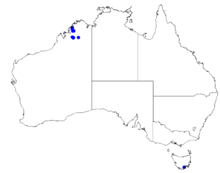Boronia pauciflora
Boronia pauciflora is a plant in the citrus family Rutaceae and is endemic to the Kimberley region of Western Australia. It is an erect shrub usually with simple leaves and white to pink, four-petalled flowers.
| Boronia pauciflora | |
|---|---|
| Scientific classification | |
| Kingdom: | Plantae |
| Clade: | Tracheophytes |
| Clade: | Angiosperms |
| Clade: | Eudicots |
| Clade: | Rosids |
| Order: | Sapindales |
| Family: | Rutaceae |
| Genus: | Boronia |
| Species: | B. pauciflora |
| Binomial name | |
| Boronia pauciflora | |
 | |
| Occurrence data from Australasian Virtual Herbarium | |
Description
Boronia pauciflora is an erect, many-branched shrub that grows to 60 cm (20 in) high and is only hairy when young. Its branches are more or less square in cross-section and the leaves are arranged in opposite pairs. Mature leaves are simple and have a petiole 0.5–7 mm (0.02–0.3 in) long, but juvenile leaves are trifoliate and sessile. Mature leaves and the end leaflet of juvenile leaves are elliptic to lance-shaped, 12–80 mm (0.5–3 in) long and 2–12 mm (0.08–0.5 in) wide and the side leaflets are a similar shape but shorter. The flowers are white to pink and are egg-shaped to triangular, usually arranged singly, sometimes in groups of up to three, in leaf axils on a pedicel 4–23 mm (0.2–0.9 in) long. The four sepals are egg-shaped to triangular, 2.5–4.5 mm (0.1–0.2 in) long and 1–2 mm (0.04–0.08 in) wide but almost double in size as the fruit develops. The petals are a similar size to the sepals and scarcely enlarge as the fruit develops. Flowering occurs from May to July.[2][3][4]
Taxonomy and naming
Boronia pauciflora was first formally described in 1918 by William Vincent Fitzgerald from a specimen he collected "above the base of Mt. Broome, King Leopold Ranges" (modern-day Wunaamin Miliwundi Ranges). The description was published in Journal and Proceedings of the Royal Society of Western Australia.[5][6] The specific epithet (pauciflora) is derived from the Latin words paucus meaning "few" or "little" and -florus meaning "flowered".[7]
Distribution and habitat
This boronia grows in rocky places near the Prince Regent River, Edkins Range and King Leopold Ranges in the Kimberley region.[4][8]
Conservation
Boronia pauciflora is classed as "Priority Three" by the Government of Western Australia Department of Parks and Wildlife[8] meaning that it is poorly known and known from only a few locations but is not under imminent threat.[9]
References
- "Boronia pauciflora". Australian Plant Census. Retrieved 10 April 2019.
- Duretto, Marco (1999). "Systematics of Boronia section Valvatae sensu lato (Rutaceae)" (PDF). Muelleria. 12 (1): 111–112. Retrieved 10 April 2019.
- Duretto, Marco F. (1997). "Taxonomic notes on Boronia species of north-western Australia" (PDF). Nuytsia. 11 (3): 330–332. Retrieved 10 April 2019.
- Duretto, Marco F.; Wilson, Paul G.; Ladiges, Pauline Y. "Boronia pauciflora". Australian Biological Resources Study, Department of the Environment and Energy, Canberra. Retrieved 10 April 2019.
- "Boronia pauciflora". APNI. Retrieved 10 April 2019.
- Fitzgerald, William Vincent (1918). "The Botany of the Kinberleys, north-west Australia". Journal and Proceedings of the Royal Society of Western Australia. 3: 158–159. Retrieved 10 April 2019.
- Francis Aubie Sharr (2019). Western Australian Plant Names and their Meanings. Kardinya, Western Australia: Four Gables Press. p. 272. ISBN 9780958034180.
- "Boronia pauciflora". FloraBase. Western Australian Government Department of Parks and Wildlife.
- "Conservation codes for Western Australian Flora and Fauna" (PDF). Government of Western Australia Department of Parks and Wildlife. Retrieved 10 April 2019.
